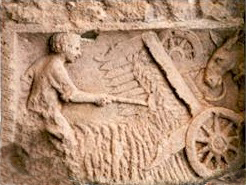
Back الزراعة في روما Arabic প্রাচীন রোমে কৃষিকাজ Bengali/Bangla Agricultura romana Catalan Agricultura y ganadería en la Antigua Roma Spanish Agriculture de la Rome antique French חקלאות ברומא העתיקה HE Հռոմեական գյուղատնտեսություն Armenian Agricultura roman Interlingua Agricoltura della civiltà romana Italian Agricultura na Roma Antiga Portuguese

Roman agriculture describes the farming practices of ancient Rome, during a period of over 1000 years. From humble beginnings, the Roman Republic (509 BC–27 BC) and the Roman Empire (27 BC–476 AD) expanded to rule much of Europe, northern Africa, and the Middle East and thus comprised many agricultural environments of which the Mediterranean climate of dry, hot summers and cool, rainy winter was the most common. Within the Mediterranean area, a triad of crops were most important: grains, olives, and grapes.
The great majority of the people ruled by Rome were engaged in agriculture. From the beginning of small, largely self-sufficient landowners, rural society became dominated by latifundium, large estates owned by the wealthy and utilizing mostly slave labor. The growth in the urban population, especially of the city of Rome, required the development of commercial markets and long-distance trade in agricultural products, especially grain, to supply the people in the cities with food.
© MMXXIII Rich X Search. We shall prevail. All rights reserved. Rich X Search